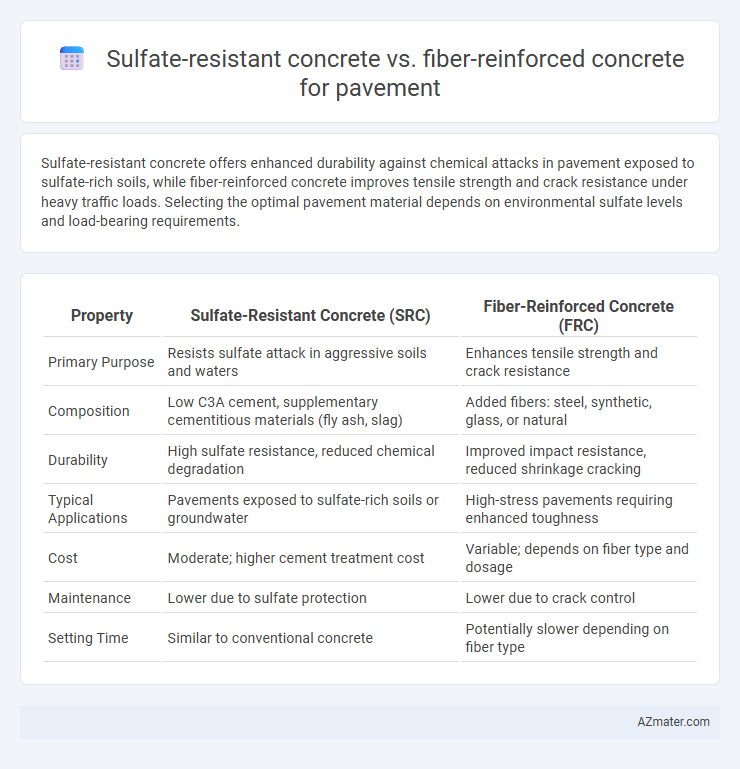Sulfate-resistant concrete offers enhanced durability against chemical attacks in pavement exposed to sulfate-rich soils, while fiber-reinforced concrete improves tensile strength and crack resistance under heavy traffic loads. Selecting the optimal pavement material depends on environmental sulfate levels and load-bearing requirements.
Table of Comparison
| Property | Sulfate-Resistant Concrete (SRC) | Fiber-Reinforced Concrete (FRC) |
|---|---|---|
| Primary Purpose | Resists sulfate attack in aggressive soils and waters | Enhances tensile strength and crack resistance |
| Composition | Low C3A cement, supplementary cementitious materials (fly ash, slag) | Added fibers: steel, synthetic, glass, or natural |
| Durability | High sulfate resistance, reduced chemical degradation | Improved impact resistance, reduced shrinkage cracking |
| Typical Applications | Pavements exposed to sulfate-rich soils or groundwater | High-stress pavements requiring enhanced toughness |
| Cost | Moderate; higher cement treatment cost | Variable; depends on fiber type and dosage |
| Maintenance | Lower due to sulfate protection | Lower due to crack control |
| Setting Time | Similar to conventional concrete | Potentially slower depending on fiber type |
Introduction to Pavement Concrete Technologies
Sulfate-resistant concrete is engineered to withstand chemical attacks from sulfate-rich soils and water, making it ideal for pavements in harsh environments prone to sulfate exposure. Fiber-reinforced concrete incorporates synthetic or steel fibers to enhance tensile strength, crack resistance, and durability, improving the performance of pavement under heavy traffic loads and environmental stresses. Both technologies address key durability challenges in pavement construction, with sulfate-resistant concrete focusing on chemical resilience and fiber-reinforced concrete enhancing mechanical properties.
Defining Sulfate-Resistant Concrete
Sulfate-resistant concrete is specifically formulated to withstand aggressive sulfate environments by using sulfate-resistant cement types such as Type V Portland cement, reducing the risk of chemical attack and consequent structural deterioration. This concrete type is essential in pavement applications exposed to high sulfate concentrations, ensuring long-term durability and resistance to expansion and cracking caused by sulfate reactions. Unlike fiber-reinforced concrete, which improves mechanical properties like tensile strength and crack control, sulfate-resistant concrete focuses primarily on chemical resistance to enhance pavement lifespan in sulfate-rich soils or water conditions.
Overview of Fiber-Reinforced Concrete
Fiber-reinforced concrete (FRC) incorporates fibers such as steel, glass, or synthetic materials to improve tensile strength, reduce cracking, and enhance durability in pavement applications. This reinforcement enhances resistance to fatigue, impact, and shrinkage-related stresses, making FRC a versatile choice for pavements exposed to heavy loads and dynamic traffic conditions. Compared to sulfate-resistant concrete, which primarily offers chemical durability against sulfate attack, FRC emphasizes mechanical performance improvements for longer-lasting, crack-resistant pavement surfaces.
Key Properties Comparison: Sulfate Resistance vs Fiber Reinforcement
Sulfate-resistant concrete offers enhanced durability against sulfate-induced chemical attacks in aggressive soil or groundwater environments due to its low C3A content and use of supplementary cementitious materials like fly ash or slag. Fiber-reinforced concrete improves mechanical properties such as tensile strength, crack resistance, and impact toughness through the inclusion of synthetic or steel fibers, which help control shrinkage and improve load-bearing capacity in pavement structures. While sulfate-resistant concrete primarily targets chemical durability, fiber-reinforced concrete focuses on enhancing structural resilience and fracture control, making each suitable for different performance requirements in pavement applications.
Performance under Harsh Environmental Conditions
Sulfate-resistant concrete significantly enhances pavement durability in sulfate-rich soils and groundwater by minimizing chemical reactions that degrade the cement matrix. Fiber-reinforced concrete improves mechanical performance under harsh conditions through increased tensile strength, crack resistance, and impact absorption. Combining sulfate resistance with fiber reinforcement results in pavements exhibiting superior longevity and structural integrity in aggressive environments.
Durability and Longevity in Pavement Applications
Sulfate-resistant concrete offers enhanced durability in pavements exposed to sulfate-rich soils or groundwater by minimizing chemical attacks that cause deterioration and expansion. Fiber-reinforced concrete improves longevity by controlling crack propagation and providing superior resistance to fatigue and impact loads, which helps maintain structural integrity under heavy traffic conditions. Both materials extend pavement service life, but sulfate-resistant concrete is optimal for chemically aggressive environments, whereas fiber-reinforced concrete excels in mechanically demanding applications.
Cost Implications and Economic Considerations
Sulfate-resistant concrete typically incurs higher initial material costs due to specialized cement types designed to withstand aggressive sulfate environments, making it economically viable for long-term durability in sulfate-rich soils. Fiber-reinforced concrete, while often involving moderate material expenses for fibers such as steel or polypropylene, improves pavement performance by reducing cracking and maintenance needs, potentially lowering lifecycle costs. Evaluating economic considerations requires analyzing upfront investment against anticipated reductions in repair frequency and service interruptions for specific pavement applications.
Installation and Maintenance Requirements
Sulfate-resistant concrete requires careful selection of sulfate-resisting cement and controlled curing to prevent chemical deterioration, which can increase installation time and costs compared to standard concrete. Fiber-reinforced concrete incorporates synthetic or steel fibers that improve crack resistance and durability, reducing maintenance frequency and costs by limiting surface wear and cracking under traffic loads. Maintenance of sulfate-resistant concrete often involves monitoring for chemical exposure damage, whereas fiber-reinforced concrete primarily demands inspection for fiber exposure and surface integrity without extensive chemical treatment.
Suitability for Different Pavement Scenarios
Sulfate-resistant concrete is highly suitable for pavements exposed to aggressive sulfate-rich soils or groundwater, ensuring long-term durability by reducing chemical degradation. Fiber-reinforced concrete enhances tensile strength and crack resistance, making it ideal for heavy load-bearing or high-traffic pavements prone to mechanical stresses and thermal expansion. Selecting the appropriate concrete type depends on environmental conditions and structural demands, with sulfate-resistant concrete preferred for chemical resistance and fiber-reinforced concrete for enhanced mechanical performance.
Future Trends in Advanced Pavement Concrete
Sulfate-resistant concrete offers enhanced durability against chemical attacks in aggressive soil environments, making it essential for infrastructure longevity in sulfate-rich regions. Fiber-reinforced concrete improves tensile strength and crack resistance, reducing maintenance costs and extending pavement lifespan under heavy traffic loads. Future trends emphasize integrating nanomaterials and hybrid fibers to optimize performance, combining chemical resistance with superior mechanical properties for next-generation advanced pavement concrete.

Infographic: Sulfate-resistant concrete vs Fiber-reinforced concrete for Pavement
 azmater.com
azmater.com